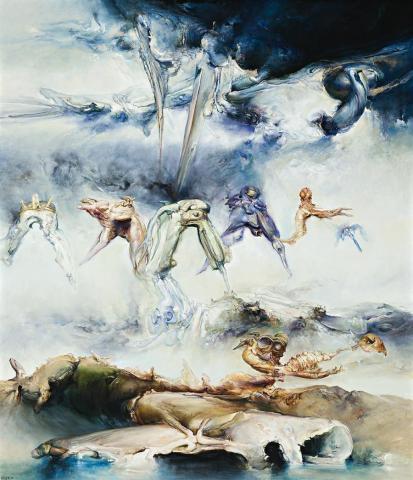THE WHARF AT THE END OF THE STREET, 1990
JAMES GLEESON
oil on canvas
179.0 x 154.0 cm
signed and dated lower left: Gleeson 90
signed and inscribed verso: “THE WHARF AT THE END OF THE STREET” / James Gleeson
Lauraine Diggins Fine Art, Melbourne (label attached verso)
Private collection, Melbourne
Deutscher~Menzies, Sydney, 7 December 2005, lot 63
Private collection, Queensland
'There is an unknown quality to these landscapes. The landscape is not ours, in the sense that Turner's was, and yet it is. Gleeson has come back to the early Greek elements -water, earth, air, fire.'1
The familiar yet foreign landscapes that Gleeson creates are representations of dreams and subconscious thoughts that we have all experienced. Dark and devouring or light and harmonious, his landscapes are a manifestation of our subjective imagination and inner psyche. The Wharf at the End of the Street is such a composition, typical of Gleeson's Surrealist style. The top of the sky is bleak and ominous, while grotesque forms emerge from the ocean and clouds. While there are no distinctly human figures present in this composition, the presence of humanity is everywhere, capturing the fear of the unknown through to the ecstasy of intellectual curiosity.
During the second period of Gleeson's career from 1983 until his death in 2008, Gleeson 'embarked on large imaginative landscapes which constitute his greatest and most original achievement'.2 As demonstrated in the picture on offer, the human figure takes on a more metaphorical form as opposed to the human figures that featured in his earlier works, reaching an allegorical state. 'I got to the point where the extreme (of the figure) almost came to be recognisable - then I felt no need to use the form at all as an entirety. It could be represented by an arm, a hand, an eye. I broadened it to be not only landscape but cosmic experience'.3
1. Klepac, L., James Gleeson: Beyond the Screen of Sight, The Beagle Press, Sydney, 2004, p. 60
2. Ibid., p. 13
3. Gleeson, cited in Free, R., James Gleeson: Images from the Shadows, Craftsman House, Sydney, 1993, p. 12
CASSI YOUNG
